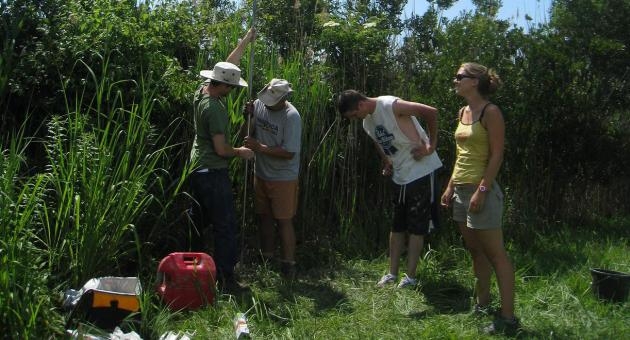Seaside detectives search coastline for clues about storms of yesteryear

It was a perfect day — clear, sunny and not too hot — as professor Ilya Buynevich and his students dug down 23 feet below the ground at Sewell Point in Cape May, N.J. The seaside detectives were looking for clues that would reveal how coastal wetlands evolved in prehistoric times.
Buynevich, a Temple geology professor, was working closer to home than he usually does. His research has taken him to coastlines across the world, from the Baltic and Black Seas, to New England, Kuwait and Brazil. Everywhere he goes, his goal is the same: To better understand how extreme weather events, such as storms or tsunamis, alter beaches, dunes and tidalinlets. The information he gathers is crucial to determining how future events might affect coastal communities and regions, some of which face intense pressure due to changing sea levels and beach erosion.
“Massive damage to coastal communities and dramatic landscape changes associated with large storms can be understood better when put in the context of long-term evolution of coastal systems,” said Buynevich.
In Cape May, Buynevich was gathering data with graduate student Bryan Narwich for his thesis research on the evolution of prehistoric coastal wetlands. Back in the lab in Beury Hall on Main Campus, they will compare their samples from Cape May to existing data from the Delaware Bay and Central New Jersey coast.
The sediment they unearthed bore a number of telling signatures of storms past. On the top were several feet of fill from the dredging of the Cape May harbor 100 years ago. Next came mud with several layers of sand, which Buynevich believes reflects sand flux through the nearby inlet during prehistoric (pre-1600s) storms.
Marsh plant remains will undergo radiocarbon dating to determine when storm damage occurred and how fast sediment accumulated. Mudsnails, which lay entombed about 17 feet down, can be up to 1,000 years old, explained Buynevich, based on similar fossils found in cores nearby last year and dated at 700 years.
“These snails not only provide information on the ancient environments, but also serve as good sea-level indicators because they prefer to live between the high and low tide marks,” he said, adding that the study of these fossils are part of an undergraduate research project led by geology major Eve Eisemann.
The researchers will also be looking for chemical and magnetic anomalies in the mud samples as part of their quest to find new methods of identifying past events, especially in areas where there’s a dearth of distinct sand layers.
The study of coastlines continues to advance as new technologies help to reveal new clues about past storms.
“We have the potential of reconstructing coastal evolution over tens of thousands of years, said Buynevich, “which is crucial to our understanding of future coastal vulnerabilities.”